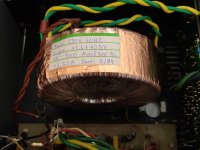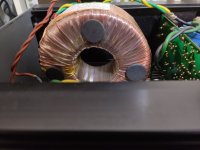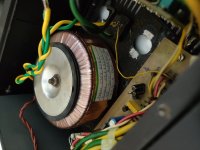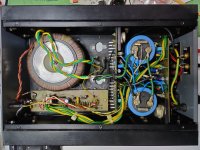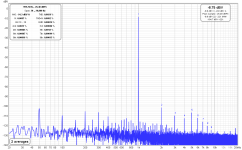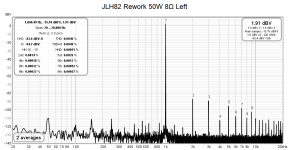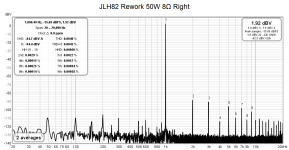I hate to judge to hastily but can I be the only one who ever got good results from wrapping transformers with mu metal? What are the odds? By the way, mu metal works great wrapped around video cables too.
When building a PS into a piece of gear, I always use copper mesh around the entire transformer with sufficient air space between the transformer and copper mesh cage. The cage is a parasitc shorted turn to the transformer, so spacing it is critical to avoid excess heat and current load, but being mesh, it allows air flow around the transformer and the copper itself conducts heat away through the enclosure mass and venting. Transformers with copper shorting bands tend to run hot due to parasitic loss described above. In the case of a toroid, the best solution is mechanical placement angle to the enclosure. This can be done by mounting the transformer on a small yoke to be able to adjust angles in the 3 dimensions.
Even self adhesive copper tape as shield made a serious difference for harmonic noise interference in a 90s made shoe-box diy amp I reworked two years ago. Its 50Hz went down by 22dB or so. The thin copper film went warm but not hot.I have only ever used a GOSS band on power transformer. I guess the copper Gauss shield, or ‘enclosure’ would really be something that operates at HF?
Attachments
Salas, thanks for posting this. Do you know how the radiated field was coupling into your circuit ie was it magnetic through cutting a wiring loop or was it via capacitive coupling into a hi-z part of the circuit? Elvee probably has a better view on this - the physics of the coupling mechanism with thin copper shields like this I find very interesting.
Last edited:
It was stronger on the nearer channel pcb. Rotating the trafo had an impact too. If this info gives you clues.
I don't think so, that would rapidly get extremely hot and melt.The cage is a parasitc shorted turn to the transformer
Only if it runs right through the core and connects on the outside. Thats why you never mount a torroid with a conductive fastener (bolt) running through the core center connecting the top and bottom panel of the metal enclosure.I don't think so, that would rapidly get extremely hot and melt.
Spaced away by a cm or so, a cage around a transformer barely effects the output.
Looking at your plots Salas, I think it’s leakage flux mag coupling since the improvement is at LF if I’m reading it right. Hopefully Elvee will comment.
The principal harmonics are even, meaning they originate from the rectifier rather than the transformer. A parasitic DC component of the mains might have the same effect, but I am not sure about that; may need to do some physical tests
I'm going to give this a go. Comments and thoughts welcome.
My hifi power supply is run through one of these currently (8k version): http://www.one4power.co.uk/westwick.pdf
The main power sockets are within inches of a 8kVA toroid transformer and there is nothing between the transformer and the sockets. My hypothesis is that the field produced by the transformer could be introducing noise on the output power lines due to the proximity of the sockets to the transformer.
I am proposing to circle the toroid with 2 layers of mu-metal. my recipe is this:
1) Directly around the transformer I'll put a 5mm layer of neoprene or similar
2) wrap first layer of mu-metal
3) 2nd layer of 5mm thick neoprene
4) 2nd layer of mu-metal
5) I will need to add an outside layer of non-conductive material...('ve not decided what this should be yet)
This is the mumetal that I believe @geoffkait was referring to: https://www.ebay.co.uk/itm/152491911889 Sadly this isn't available in UK so I was proposing this https://www.ebay.co.uk/itm/154365860339 and have asked vendor for the spec of the metals used (not listed!)...I'll report back.
I wasn't initially proposing to cover the top of the transformer but will follow up in round 2, by doing this. Regarding the bottom of the case the transformer is directly mounted to steel plate on the base of the case and I am not confident of being able to manhandle the transformer...it's v heavy...around 80KG.
Cheers for reading.
My hifi power supply is run through one of these currently (8k version): http://www.one4power.co.uk/westwick.pdf
The main power sockets are within inches of a 8kVA toroid transformer and there is nothing between the transformer and the sockets. My hypothesis is that the field produced by the transformer could be introducing noise on the output power lines due to the proximity of the sockets to the transformer.
I am proposing to circle the toroid with 2 layers of mu-metal. my recipe is this:
1) Directly around the transformer I'll put a 5mm layer of neoprene or similar
2) wrap first layer of mu-metal
3) 2nd layer of 5mm thick neoprene
4) 2nd layer of mu-metal
5) I will need to add an outside layer of non-conductive material...('ve not decided what this should be yet)
This is the mumetal that I believe @geoffkait was referring to: https://www.ebay.co.uk/itm/152491911889 Sadly this isn't available in UK so I was proposing this https://www.ebay.co.uk/itm/154365860339 and have asked vendor for the spec of the metals used (not listed!)...I'll report back.
I wasn't initially proposing to cover the top of the transformer but will follow up in round 2, by doing this. Regarding the bottom of the case the transformer is directly mounted to steel plate on the base of the case and I am not confident of being able to manhandle the transformer...it's v heavy...around 80KG.
Cheers for reading.
May I ask on what basis did you formulate your hypothesis? Is it an effort to explain some experimental result or perhaps an observation?My hypothesis is...
Either its a shorted turn (turn means something precise here) or it isn't. A loop not linked with the core is not a turn.Only if it runs right through the core and connects on the outside. Thats why you never mount a torroid with a conductive fastener (bolt) running through the core center connecting the top and bottom panel of the metal enclosure.
Spaced away by a cm or so, a cage around a transformer barely effects the output.
Its not a full turn. It can be similar to a partial turn.A loop not linked with the core is not a turn.
The problem in this thread may be that if we hear something, we may make wrong conclusions. Often the problem is not radiating from a transformer, even if it seems so. I have been building amps for decades and found many different causes for unwanted noise at the speaker.
The first thing to accept is a toroid or other large transformer sometimes getting loud for a while. Even in Germany, where the mains current is considered quite "clean" and constant, we often have a temporary DC voltage on the AC line. This makes transformer hum very loud.. There is a quite simple diode-capacitor cirquit to remove DC from AC, but it may make power amps sound less dynamic in some cases. So if the power transformer acts up on times, there is no way to modify the amp inside to improve on this. Snake oil seller have many overpriced "sollutions" for this problem which needs material for a few $. So there is a lot of money to be made...
Another problem is voltage between components.
Next internal hum of a single component, caused by ground loops, which can be a design flaw or defect.
One of the last, real causes is induced hum, which can be shielded. Carefull design and placement of components can prevent this. There are many amps around, 100% silent, that have huge power cramped into a small case without any exotic shielding. It can be done!
A good idea is to place the transformer a foot or 30cm away from the amp case during the phase of wireing. So any hum is not caused by magnetic coupling. If it is 100% silent, add the transformer, you will instantly see when it makes trouble.
The first thing to accept is a toroid or other large transformer sometimes getting loud for a while. Even in Germany, where the mains current is considered quite "clean" and constant, we often have a temporary DC voltage on the AC line. This makes transformer hum very loud.. There is a quite simple diode-capacitor cirquit to remove DC from AC, but it may make power amps sound less dynamic in some cases. So if the power transformer acts up on times, there is no way to modify the amp inside to improve on this. Snake oil seller have many overpriced "sollutions" for this problem which needs material for a few $. So there is a lot of money to be made...
Another problem is voltage between components.
Next internal hum of a single component, caused by ground loops, which can be a design flaw or defect.
One of the last, real causes is induced hum, which can be shielded. Carefull design and placement of components can prevent this. There are many amps around, 100% silent, that have huge power cramped into a small case without any exotic shielding. It can be done!
A good idea is to place the transformer a foot or 30cm away from the amp case during the phase of wireing. So any hum is not caused by magnetic coupling. If it is 100% silent, add the transformer, you will instantly see when it makes trouble.
not really...it's an idea that I want to explore based around the conversation here and in other threads. The fact that I have an 8kVA transformer about a 20cm away from a mono block (albeit with 1/8" of aluminium and a steel frame between the components) due to space constraints and significant but unshielded socketry very close to a huge transformer with no GOSS shield and I'm pretty sure no electrostatic shield either, just makes it a scratch that I want to itch.May I ask on what basis did you formulate your hypothesis? Is it an effort to explain some experimental result or perhaps an observation?
You can take a cheap high impedance coil and connect it to an amp like a microfone. If you move it near an electro magnetic AC field, you can hear it get louder, locate it and define it's reach. Maybe such a simple dector could give you peace of mind.
By the way, you can expect such fields get weaker with the 3rd power, so something very prominent, 1 cm away, may be not noticeable in 20cm distance.
This is because, roughly, most of these fields radiate their energy all around the source, like a sphere.
By the way, you can expect such fields get weaker with the 3rd power, so something very prominent, 1 cm away, may be not noticeable in 20cm distance.
This is because, roughly, most of these fields radiate their energy all around the source, like a sphere.
- Home
- Amplifiers
- Power Supplies
- magnetic shielding/how to defeat hum-pickup
